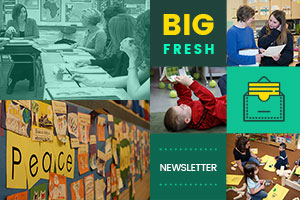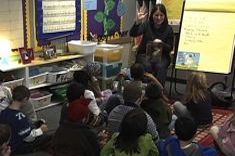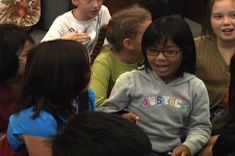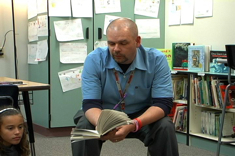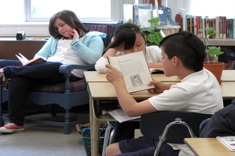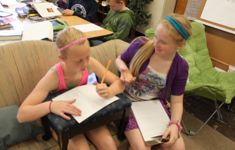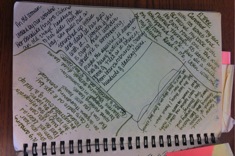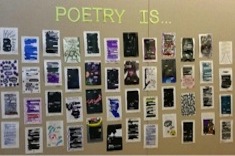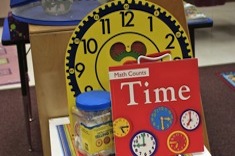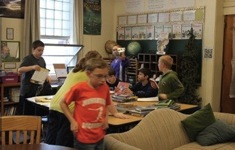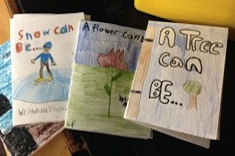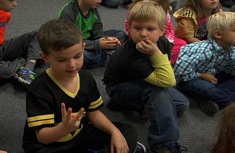Library
Choice Literacy Articles & Videos
The Choice Literacy library contains over 3,000 articles and 900 videos from 150+ contributors. Classic Classroom and Literacy Leadership subscribers have access to the entire library. Content is updated continuously, with five to six new features published each week.
Latest Content
Book Blurbs in the Middle School Classroom
Jillian Heise uses the quirky genre of book blurbs in her middle school classroom to model summaries and glean information about students’ comprehension, reading interests, and writing skills.
The Big Fresh March 28, 2015 The Devotion of Reading Teachers
We consider the value of reading aloud to students in this week’s Big Fresh.
Researching Like Writers: From Read-Aloud to Notebooks
Katie Doherty finds read alouds are a valuable tool for developing middle school writers.
Intervening with Read Aloud
Jan Burkins and Kim Yaris are using read alouds as an intervention strategy with struggling learners.
Whole-Class Conversations for Read Aloud Closure
Melanie Swider discovers that conversations after read alouds are a wonderful way for students to remember and retain the learning from shared texts.
Percy Jackson Read-Aloud in Fourth Grade
Tony Keefer demonstrates how he makes his read-alouds interactive, and explains why he selected Percy Jackson to use with this group of fourth graders.
Releasing Responsibility
When it comes to producing independent readers and writers in classrooms, it’s all about the language we use. Debbie Miller has practical suggestions for bringing out the best in children.
The Big Fresh March 21, 2015 Taking Detours
We look at the spring slump in this week’s Big Fresh.
Surviving “That Class”
Sometimes you get a class of students that pushes every one of your buttons. Shari Frost provides a case study of one teacher’s survival strategies.
Anchor Chart Changes
Mary Lee Hahn finds midyear is the perfect time for refreshing anchor charts.
Weekly Check-In Sheets
Are you finding effort from students is flagging? Katherine Sokolowski develops check-in sheets as a way to lift student energy and reflection.
The Big Fresh March 14, 2015 Eating an Orange
Notebooks are the focus of this week’s Big Fresh.
One Tool, Many Uses: Poetry Notebooks
Shari Frost explains how teachers get creative with poetry notebooks.
Giving Students a Notebook Tour
Melanie Meehan finds a notebooks tour is a terrific minilesson for helping students expand the ways they use notebooks.
Blackout Poems and Paint-Chip Haiku: Two Fun Ways into Poetry with Adolescents
Jillian Heise uses the lowly paint-chip board to inspire poetry in her middle school students.
Catching Up with Anna
Katie Doherty Czerwinski tackles the challenging issue of helping a student catch up in book clubs and reading workshop when they have missed a lot of class time.
Using a Sketchbook as a Tool to Teach Grammar
Melanie Swider describes how she develops notebook pages for minilessons and conferring.
Notebook Sketching: Conferring with Sarah
Aimee Buckner confers with Sarah about sketching in her notebook.
Conferring with Izzy
Ruth Ayres confers with Izzy to help her create an organizer in her writing notebook.
The Big Fresh March 7, 2015 The Power of Play
We look at play in this week’s Big Fresh.
The Secret to Productivity: Hard Work or Play?
Jan Burkins and Kim Yaris connect their own working lives to those of students, and consider the value of play.
Three Classroom Games for Literacy Learning and Laughter
Melanie Meehan suggests some favorite classroom games for building literacy skills.
Integrating Student Teachers into Literacy Workshops
Katherine Sokolowski gives advice for integrating student teachers into literacy workshop instruction.
The Big Fresh February 28, 2015 The Ketchup Incident
We look at welcoming school guests (even unhappy ones) in this week’s Big Fresh.
The Secret to Magical Author Visits
Prolific children’s book author Laura Purdie Salas explains why you should treat visiting authors like rock stars, with many tips and examples from her writing friends.
Integrating Paraprofessionals into Reading Workshops
Justin Stygles decides he needs to completely rethink the role of classroom aides.
Channeling Monet
Andie Cunningham deals with the tension of welcoming an unhappy parent into her kindergarten classroom.
First-Grade Math Lesson: Concept Practice and Conclusion
Danielle French's first graders continue to test out new math concepts and language in the conclusion of this lesson series.
The Big Fresh February 21, 2015 What Comes First
There is never enough in schools to do all we need to do, so that is the focus of this week’s Big Fresh.
How Long?
Ruth Ayres provides a ready reference guide for the typical length of everything from a minilesson to a conferring session.
Browse Content By
Type
Category
- Assessment Tools
- Big Fresh Archives
- Booklists
- Choice Numeracy
- Classroom Design
- Common Core
- Community Building
- Conferring
- Content Literacy
- Digital Literacy
- English Language Learners
- Equity
- Family Relations
- Free Samples
- Guiding Groups
- Leadership
- Literacy Coaches
- Mentor Texts
- Minilessons
- New Teacher Mentors
- Podcasts
- Poetry
- Quote Collections
- Reading Strategies
- Self Care
- Struggling and Striving Learners
- Talking and Listening
- Teacher Study Groups
- Teaching Reading
- Teaching Writing
- Word Study and Vocabulary
Author
- Melissa Quimby
- Nawal Qarooni
- Gwen Blumberg
- Julie Cox
- The Lead Learners
- Hannah Tills
- Josie Stewart
- Ruth Metcalfe
- Mallory Messenger
- Becca Burk
- Jodie Bailey
- Vivian Chen
- Mary Brower
- Tiffany Abbott Fuller
- Stephanie Affinito
- Ruth Ayres
- Leigh Anne Eck
- Heather Fisher
- Shari Frost
- Julie Johnson
- Suzy Kaback
- Gigi McAllister
- Shirl McPhillips
- Melanie Meehan
- Cathy Mere
- Debbie Miller
- Tara Barnett and Kate Mills
- Tammy Mulligan
- Dana Murphy
- Bitsy Parks
- David Pittman
- Brenda Power
- Heather Rader
- Matt Renwick
- Mandy Robek
- Christy Rush-Levine
- Gretchen Schroeder
- Jen Schwanke
- Brian Sepe
- Katherine Sokolowski
- Stella Villalba
- Jennifer Vincent
Grade Level
Choice Literacy Membership
Articles
Get full access to all Choice Literacy article content
Videos
Get full access to all Choice Literacy video content
Courses
Access Choice Literacy course curriculum and training


